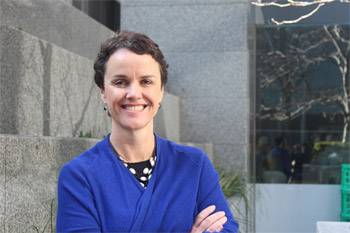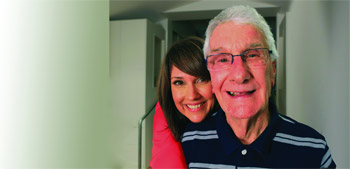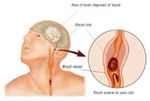Dr Erin Lalor World Stroke Day Interview

Dr Erin Lalor World Stroke Day Interview
By media personality and National Stroke Foundation advocate Chris Bath
I'll bet if you're asked to list terrible diseases attacking women, breast cancer would be in your top three. That's largely because breast cancer campaigners nailed the "I am woman hear me roar" thing. They raised hell until they made people and politicians care, increased funding, awareness, improved treatment and #BOOM survival rates worldwide improved. Hats off to them!
But would it surprise you to learn that stroke kills more women than breast cancer? Probably. There's bugger all funding to warn people about stroke in Australia.
So here are the facts. One in five women will have a stroke. Women have them at any age. If they survive, the disability stroke causes can be catastrophic. That's why this World Stroke Day on October 29, the theme is "I am Woman". Please bear with me while I roar.
Sadly it's the bits that make us women that make us a little more susceptible to stroke than men, those bits that wondrously create life but also drive us barmy (hello menstruation and menopause...) Women have strokes while they're pregnant, are more susceptible because of birth control pills and hormone replacement therapy and also because of irregular heartbeat. Sixty percent of people who will die from strokes are women.
 Then there's the other side of stroke. Three in four people caring for stroke survivors - a partner, father, mother, daughter or son - are women. There is very little support or recognition for them. It's a relentless, full time job, one I've watched my mother tackle for the past six years since my Dad had a stroke in 2009.
Then there's the other side of stroke. Three in four people caring for stroke survivors - a partner, father, mother, daughter or son - are women. There is very little support or recognition for them. It's a relentless, full time job, one I've watched my mother tackle for the past six years since my Dad had a stroke in 2009.
So as a woman, how do you prevent a stroke? Well it's the usual healthy living messages: stop smoking, eat healthily, stay active, watch your weight, drink booze in moderation, reduce stress but also make sure you get your blood pressure checked regularly, especially if you're pregnant or taking the pill or HRT. Around four million Australians are living with high blood pressure and it's the number one cause of stroke. You can't feel it or see it, so you need to get it checked and it's a far more pleasant proposition than a pap smear or even a mammogram, no excuses ladies!!!
Stroke is a largely preventable disease but until Governments wake up and fund awareness, treatment and research programs, it will continue to wreak havoc across Australia. There's a stroke here every ten minutes. The criminal thing is most of them are preventable.
So how can you help?
Find out more about stroke and the World Stroke Organization campaign and share this link with the women you care about and even those you don't know and be part of the #iamwoman global campaign to save women around the world from death and disability.
For more information, please see:
I am Woman World Stroke Day campaign video
National Stroke Foundation FAST tvc
www.strokefoundation.com.au
Interview with Dr Erin Lalor
Question: Why do you believe women are unaware of strokes even though 'a stroke kills more women than breast cancer"?
Dr Erin Lalor: Globally women run a higher risk of stroke and are more likely than men to die as a result of this terrible disease. More than 6,000 women die each year compared with around 4,000 men. Despite these sobering statistics too many women are not aware of their stroke risk. This World Stroke Day the National Stroke Foundation is joining the global campaign to raise awareness of what can be done to save women's lives. As part of World Stroke Day we're calling on the Federal Government to take action to stem the tide of deaths and devastation caused by stroke. We desperately need an accessible, affordable integrated health check program to detect women's risks of developing heart disease, stroke, chronic kidney disease or type 2 diabetes at general practitioners (GPs) nationally.
Question: Why are strokes so common within the Australian population?
Dr Erin Lalor: In Australia there are more than 50,000 strokes every year. Sadly many of these strokes could have been prevented and thousands saved from death and disability as a result. Some of the biggest risk factors for stroke are things we can modify. Things like high blood pressure, smoking, poor diet and lack of exercise all increase your likelihood of having a stroke in your lifetime. Too many people think stroke won't happen to them, a health assessment from a trusted GP is often the wake-up call they need. Stroke is not going to go away on its own. A national health check program will empower Australians to take control of their health and save themselves from stroke.
Question: What are the symptoms associated with a stroke?
Dr Erin Lalor: A stroke is the way we describe the blood supply to the brain being suddenly cut off. A stroke can happen in two ways: Blood can stop moving through the artery when it gets blocked by a clot - or when the artery bursts. Brain cells can quickly die without the oxygen that the blood supplies. This is why it is so important to get to hospital immediately if you think you are having a stroke because it is possible there may be some cells that can survive if you are treated quickly. We have an easy way for everyone to recognise the signs of stroke: FAST
Face – has the person's face drooped?
Arms – can the person raise both arms?
Speech – is their speech slurred?
Time – call 000 immediately.
Question: How does a stroke affect women?
Dr Erin Lalor: One in five women are at risk of stroke due to factors such as high blood pressure, being physically inactive and poor diet. There are also factors specific to women such as pregnancy, hormone replacement therapy and the contraceptive pill which can increase the risk of stroke in some people. Thankfully there are things we can all do to reduce our risk – a great first step is getting a health check with your GP. If you know you are at risk of stroke you can take action to manage that risk.
Here is a snapshot of the impact of stroke in women:
23,913 strokes occurred in women in 2013
There are 192, 869 women stroke survivors living in the community
One in five women are at risk of stroke:
29 percent of women have high blood pressure
58 percent of women are physically inactive
94 percent of women do not eat enough fruit and vegetables
Three out of four carers of stroke survivors are women
Question: Can you talk about the disabilities strokes causes?
Dr Erin Lalor: Every stroke is different. Each person affected by stroke will have different problems and different needs. The way in which you might be affected depends on where in the brain the stroke happens and how big the stroke is. A stroke on the right side of the brain generally causes problems on the left side of the body. A stroke on the left side of the brain causes problems on the right side of the body. Some strokes happen at the base of the brain and can cause problems with eating, breathing and moving.
Question: What are your top tips for avoiding a stroke?
Dr Erin Lalor: There are simple things we can all do to help protect ourselves from stroke. We recommend eating well, keeping a healthy weight, stopping smoking, managing your blood pressure, exercising regularly, keeping alcohol consumption to a minimum and getting a regular check up with your health professional.
Question: What do you hope to achieve with World Stroke Day?
Dr Erin Lalor: World Stroke Day is an opportunity to raise awareness of the impact of stroke and what can be done to save lives. This year we want all Australians to look at what they can do to reduce their risk of stroke. Visit the National Stroke Foundation website to find out how you can get involved.
Interview by Brooke Hunter
Have You Seen This?
MORE






